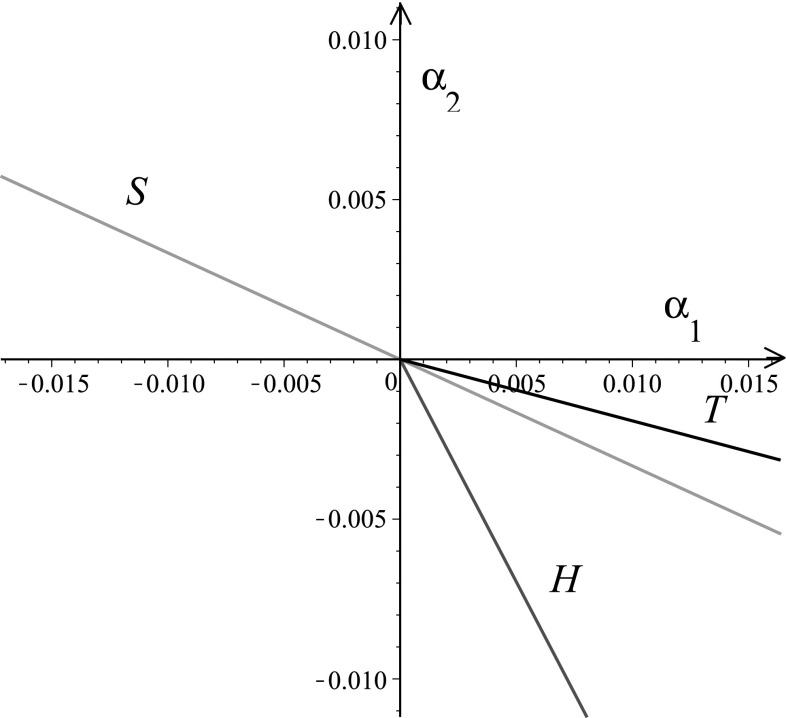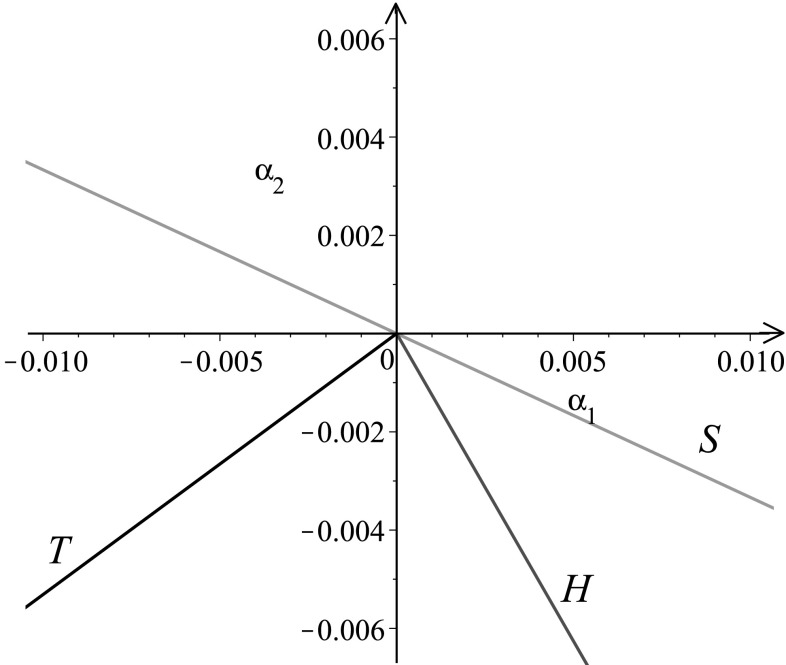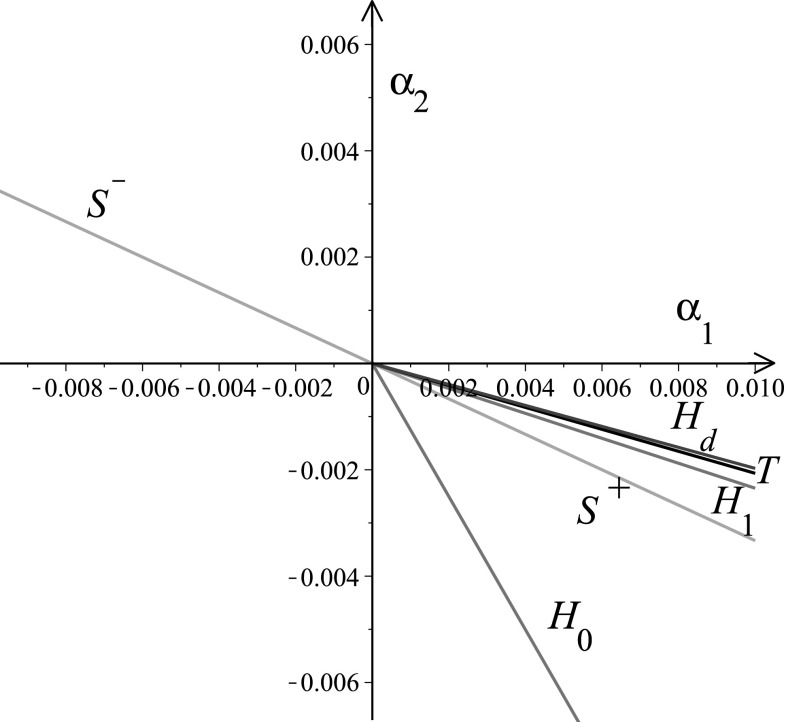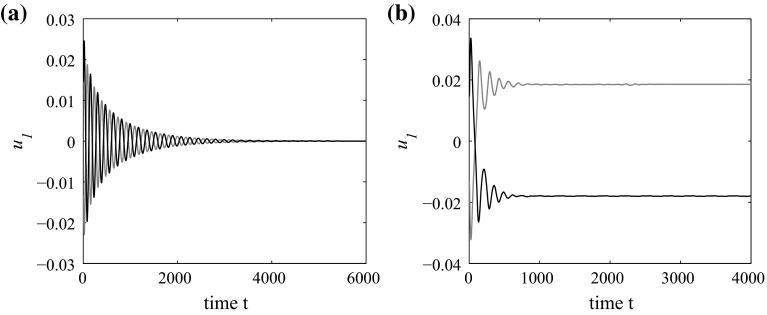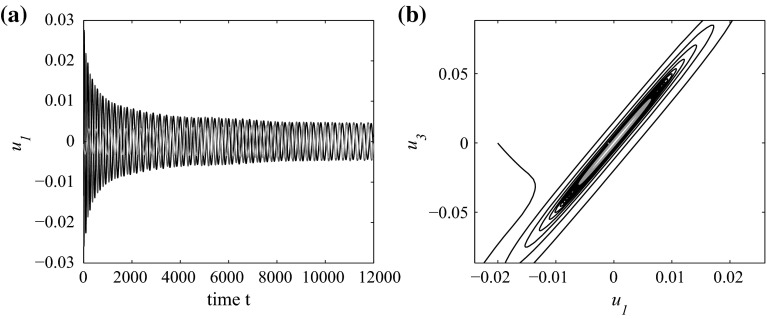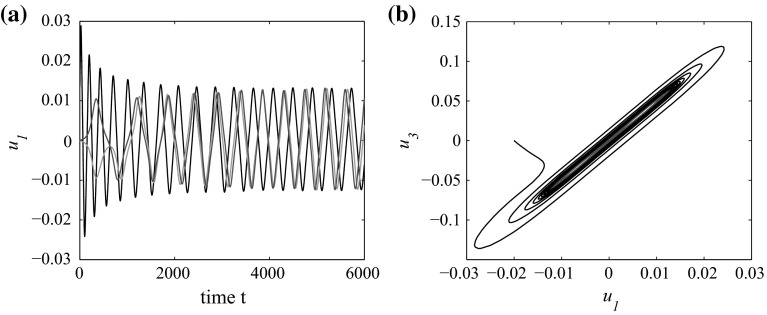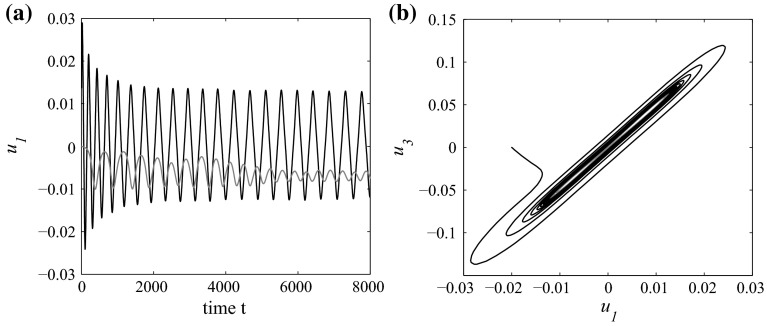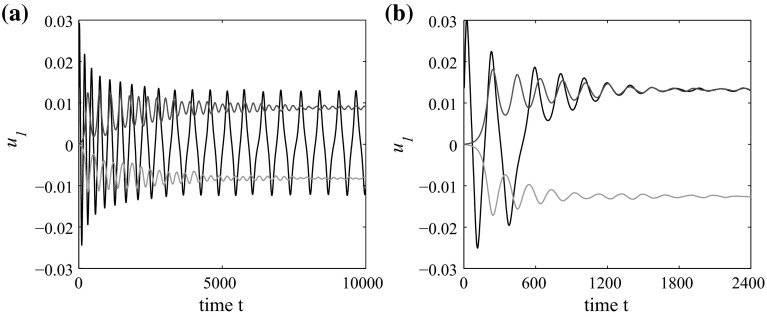Abstract
In this article, the high codimension bifurcations of a six-neuron BAM neural network system with multiple delays are addressed. We first deduce the existence conditions under which the origin of the system is a Bogdanov–Takens singularity with multiplicities two or three. By choosing the connection coefficients as bifurcation parameters and using the formula derived from the normal form theory and the center manifold, the normal forms of Bogdanov–Takens and triple zero bifurcations are presented. Some numerical examples are shown to support our main results.
Keywords: Neural networks, Bogdanov–Takens bifurcation, Triple zero bifurcation
Introduction
It is believed that the successful applications of neural network in many fields such as optimization solvers, pattern recognition, automatic control and encryption of image (Cochoki and Unbehauen 1993; Ripley 1996; He et al. 2013; Kadone and Nakamutra 2005; Hoppensteadt and Izhikevich 1997) heavily depend on the theoretical studies about the neuron systems, especially the investigation of the dynamical behaviors of neural network models has became focus over the past decade years.
Following currently available literatures, the interest in studying the dynamics of the neural network has focused on two main aspects. One topic is aimed at the study of the local and global stability of the equilibrium, the existence and stability of periodic solutions yielded from Hopf bifurcation, as reported in (Xu and Li 2012; Yang and Ye 2009; Xu et al. 2011; Cao 2003; Sun et al. 2007; Zheng et al. 2008; Liu and Cao 2011; Yang et al. 2014), and another topic is aimed at the study of more complex dynamics mainly involving some degenerate bifurcations existing in the neighborhood of the codimensional singularity. Such issues have been addressed by several articles (Ding et al. 2012; He et al. 2012a, b, 2013, 2014; Li and Wei 2005; Dong and Liao 2013; Song and Xu 2012; Campbell and Yuan 2008; Guo et al. 2008; Yang 2008; Liu 2014; Garliauskas 1998; Kepler et al. 1990). For instance, Ding et al. (2012) have considered the zero–Hopf bifurcation of a generalized Gopalsamy neural network model, the normal forms of near a zero–Hopf critical point were deduced by using multiple time scales and center manifold reduction methods respectively. The similar work has been carried out by He et al. (2014), but contraposing a different neural network. The authors in (Dong and Liao 2013; He et al. 2012a; Li and Wei 2005; Song and Xu 2012, 2013; Campbell and Yuan 2008; Guo et al. 2008; Yang 2008) have devoted to the analysis of the Bogdanov–Takens (B–T) bifurcation with codimension two. Guo et al. have deduced the existence of the double Hopf (Guo et al. 2008). Campbell and Yuan (2008) and Liu (2014) have investigated triple zero bifurcation induced by the delays and the connection topologies existing among the neurons. For the cases of Hopf–Pitchfork bifurcation and chaos see (Yang 2008; Garliauskas 1998; Kepler et al. 1990).
In application of neural networks, some dynamical phenomena of neural networks have been explained and shown by simulations and applied to memory systems and algorithmic designs (Kadone and Nakamutra 2005; Hoppensteadt and Izhikevich 1997; He et al. 2013; Chen and Aihara 1999; Wang and Shi 2006). For example, attractors, homoclinic and heteroclinic orbits can be interpreted as a single storage or memory pattern, or an optimal object, and various complex patterns in the application and design of neural networks. Chaotic behavior of neural networks also has been confirmed to be benefit to design the efficient searching algorithm for solving optimization problems due to its bidirectional structure (Chen and Aihara 1999; Wang and Shi 2006). Undoubtedly, the deeper investigations to dynamic of neural networks facilitates the extensive applications and optimum design of some searching algorithms. This also motivate us to study the more complicated bifurcation behaviors of delayed multi-neuron memory systems, especially, the codimension-2 and codimension-3 bifurcations.
Due to the complexity of the problem, more attentions on the investigations of multiple-delay neural network focus on small sized networks or on some special architecture (Sun et al. 2007; Zheng et al. 2008; Dong and Liao 2013; He et al. 2012a). Although, it is convinced that the dynamics investigation to neural networks with a few neurons contributes to understanding large-scale networks, there are inevitably some complicated and pivotal problems that may be neglected if large-scale networks is simplified. On the other hand, from the practical point of the view, improving the designs of the neural networks and extending its application in more fields also need consider the more complex and larger-scale associative models because the real neural networks are complex and large-scale nonlinear dynamical systems, and commonly involve interactions among multiple neurons. For example, the exact control to the roughness of categorization by the proportion between excitatory signal and inhibitory signal depends on the complex layered design (Carpenter and Grossberg 1987). Meanwhile it also is an important mathematical subject to investigate the dynamics of the larger scale neuron systems (Xu and Li 2012; Xu et al. 2011; Yang and Ye 2009; Cao 2003; Liu 2014). As Xu and Li (2012) have studied a bidirectional associative memory (BAM) six-neuron networks, which is described by
| 1 |
where denotes the state of the neuron at time t; characterizes the attenuation rate of internal neurons processing on the I-layer and the J-layer and ; the real constants and show the connected weights between the neurons in two layers: the I-layer and the J-layer.
Xu and Li (2012) have considered the stability of the nondegenerate origin and the existence of Hopf bifurcation of (1) induced by the delays. Compared with (Xu and Li 2012), the contributions of this work are to address Bogdanov–Takens and triple zero bifurcation computations of the BAM six-neuron network, and show the curves of different bifurcation occurrences.
The Hopf bifurcation is corresponding the characteristic equation has a pair of purely imaginary roots. While the B–T or triple zero bifurcation is corresponding the characteristic equation has a double-zero or triple zero root. We choose two or three parameters as the bifurcation parameters, by using the center manifold reduction and the normal form method, one can compute the normal form which is equivalent to (1). Finally, different kinds of bifurcation curves used to explain the dynamical behaviors of (1) can be drawn.
Note that the authors in (Xiao et al. 2013; Liu and Yang 2014) have considered the stability and Hopf bifurcation of some delayed neural network models with or n neurons, especially model (1) as a special case of the model in (Xiao et al. 2013) has been studied detailedly by Xu and Li (2012), nevertheless, the degenerated dynamics of system (1) at the neighborhood of the origin has never been addressed. Thus, in this article, we devote to investigate the high codimension properties of model (1). The study to the high codimension properties of the model in (Xiao et al. 2013) will be left as our future work.
The organization of this paper is: in “Existence of B–T bifurcation” section, the existence conditions under which the origin is B–T singularity are given. In “B–T bifurcation” section, by applying the center manifold reduction and normal form computation, we obtain the normal form and bifurcation curves near the origin of the neural network. In “Triple zero bifurcation” section, triple zero bifurcation is also investigated. In “Numerical examples and simulations” section, some numerical examples and simulations are shown to verify our main results. Finally, a conclusion is given to sum up our works.
Existence of B–T bifurcation
Let and , then system (1) is equivalent to the following system
| 2 |
To obtain our main results, we make the following assumptions
- (H1)
.
From (H1), we know that the origin is always the equilibrium of system (2).
Linearizing system (2) at the zero equilibrium, then it becomes
| 3 |
The characteristic equation of system (3) is
| 4 |
where
Let
| 5 |
| 6 |
| 7 |
| 8 |
- (H2)
,
- (H3)
.
Then we can get the following result.
Lemma 1
The characteristic Eq. (4) has the double zero eigenvalues if (H1) and (H2) hold, and has the triple zero eigenvalues if (H1) and (H3) hold.
Proof
By (4), we have
| 9 |
It follows from (H1) and (H2) that and
| 10 |
Thus, is a double root of Eq. (4).
Similarly, that (H1) and (H3) hold can lead to and
This completes the proof.
Next, under the conditions (H1)–(H2) or (H1)–(H3), we will find the conditions under which the other eigenvalues of Eq. (4) have negative real parts except for zero roots.
Let be a root of Eq. (4) and substitute it into Eq. (4), then separating the real and imaginary parts, we have
| 11 |
Let (H1) and (H2) hold, then one can obtain
| 12 |
Without loss of generality, we assume that Eq. (12) has at most five positive roots, denoting them as . By (11) we have
| 13 |
where
define . If Eq. (12) has no positive root, we take
Let (H1) and (H3) hold, it follows from (11) that
| 14 |
Similarly, if Eq. (14) has no positive root, we take , or else, Eq. (14) has at most four positive roots, denote them by . Following (11) we have
| 15 |
where
define .
Lemma 2
[See Ruan and Wei (2003)] Consider the exponential polynomialwhereandare constants. Asvary, the sum of the order of the zeros ofon the open right half plane can change only if a zero appears on or crosses the imaginary axis.
Lemma 3
Letandhold. All the roots of Eq. (4), except for the double zero or triple zero roots, have negative real parts if one set of the following conditions holds
- (H4)
;
- (H5)
,
with, , , .
Proof
Let –. For , Eq. (4) becomes
| 16 |
By Routh-Hurwiz criterion, we have if
| 17 |
then the rest of roots of Eq. (16) have negative real parts except .
Let –. For , Eq. (4) becomes
| 18 |
By Routh–Hurwize criterion, we know if
| 19 |
then the rest roots of Eq. (18) have negative real parts except the triple zero root. We complete the proof.
Theorem 1
Assumeholds. Then system (2) at the origin undergoes B–T or triple zero bifurcation ifandorandhold.
B–T bifurcation
In this section, we will give the normal form of B–T bifurcation by using the methods introduced in Hale and Verduyn (1993), Xu and Huang (2006). Rescaling the time by to normalize the delay, and rewriting and as and where near (0, 0), then system (2) is translated to
| 20 |
Taking the Taylor expansion of , , then system (20) takes the form
| 21 |
where
Then following (Xu and Huang 2006), the second term of the Taylor expansion of system (21) also can be expressed in the form
where
To obtain the normal form of system (21) on its center manifold, we need the following lemma.
Lemma 4
[See Xu and Huang (2006)] The bases ofPand its dual spacehave the following representations
, , ,
, , ,
where, , and , ,which satisfy
For system (21), we have
By Lemma 4, we have
where
with
and
Following the formulas in (Xu and Huang 2006), we have the following Lemma.
Lemma 5
Letandhold.Then the system (21) can be reduced to the following system on the center manifold at
| 22 |
where
Since
then the mapis regular. Hence we can get the following theorem.
Theorem 2
Letandhold.If, , on the center manifold, system (20) is equivalent to system (22).
Referring Dong and Liao (2013), system (22) has two equilibrium and , the bifurcation curves near (0, 0) in the and parameter space are the following
-
system (22) undergoes a transcritical bifurcation on the curve
,
-
at system (22) undergoes an unstable Hopf bifurcation in the half line
,
-
at , system (22) undergoes a stable Hopf bifurcation in the half line
.
In “Numerical examples and simulations” section, a numerical example is given.
Remark
From the point of the view of application, the results of Theorem 2 under the conditions (H1), (H2), (H4) and can be explained as the exchanges of various stored patterns or memory patterns occurring in perturbed system (20) when the parameters and vary in the small neighborhood of the . Notice that a stable equilibrium is corresponding to a single storage pattern, thus, when parameters pass the transcritical bifurcation curve determined by , system (20) transforms its stored patten from one to other. Similarly, system (20) can exhibit more complex memory pattern (a periodic pattern) when approach the Hopf bifurcation curve defined by , .
Furthermore, if , , to discuss the properties of the origin of system (21), we need to compute the third order normal form of the B–T bifurcation.
Let , then (21) can be decomposed as
| 23 |
where , and
| 24 |
It follows from (Faria and Magalhaes 1995; Jiang and Yuan 2007) that
| 25 |
where
| 26 |
where
To obtain the third-order normal form, it needs the decomposition
Then the canonical basis in has forty elements: , , the bases of and one can see in (Jiang and Yuan 2007).
Together with the definition of , one can obtain that the space of can be spanned by the following elements
and the complementary space can be spanned by the elements
we obtain the third order normal form of system (21) as follows
| 27 |
where the higher terms of are omitted and
After time rescaling and coordinate transformation given by , , , system (27) is equivalent to the following system
| 28 |
where , , . From (He et al. 2012a; Dong and Liao 2013) we know the bifurcations of system (28) is related to the sign of s. If , we have
- system (28) undergoes a Pitchfork bifurcation on the curve
- system (28) undergoes a Hopf bifurcation H at the trivial equilibrium on the curve
- system (28) undergoes a heteroclinic bifurcation on the curve
If , we have
- system (28) undergoes a Pitchfork bifurcation on the curve
- system (28) undergoes a Hopf bifurcation at the trivial equilibrium on the curve
- system (28) undergoes a Hopf bifurcation at the nontrivial equilibrium on the curve
- system (28) undergoes a homoclinic bifurcation on the curve
- system (28) undergoes a double cycle bifurcation on the curve
To verify above results, two numerical examples and some simulations are shown in “Numerical examples and simulations” section.
Remark
One can see if the condition , in the Theorem (2) does not holds, then with varying in the small neighborhood of , system (20) can exhibit the more complicated stored patterns or memory patterns, including the transition of stored pattern from one to two through a Pitchfork bifurcation. The two stored patterns also may lead to three kinds periodic memory patterns. In fact, a stable limit cycle (a periodic memory pattern) is yielded when cross the Hopf bifurcation curve . With moving continuously and passing the Pitchfork bifurcation curve to the side of (), two unstable nontrivial equilibria are bifurcated from the trivial equilibrium. Further, the two unstable nontrivial equilibria become locally stable stored pattern when cross the Hopf bifurcation curve which also gives rise to two unstable small limit cycles located inside the surrounding big limit cycle.
Triple zero bifurcation
To discuss the triple zero bifurcation of system (20), we rewrite , and as , and , where vary near (0, 0, 0), taking the Taylor expansion then system (20) becomes
| 29 |
where
Then following Qiao et al. (2010), the second term of the Taylor expansion of system (29) also can be expressed in the form
where,
| 30 |
the other coefficient matrices are the same as them in (22).
To obtain the normal form it also needs to compute the corresponding expressions of and of system (29) by using the following Lemma.
Lemma 6
[See (Qiao et al. 2010)] The bases ofPand its dual spacehave the following representations
where, and, , , , which satisfy
The expressions of coefficient matrices A and B see (30), but it needs change as , then together with Lemma 6, we can obtain the expressions of and as follows:
where
with
and
with
such that , , , where
The normal form of system (29) on its center takes the form
| 31 |
where
One can see that
where
Theorem 3
Let, andhold. If, , then on the center manifold, system (29) is equivalent to the normal form (31).
Following Campbell and Yuan (2008) the bifurcation diagrams of system (31) at the origin are as follows:
Numerical examples and simulations
In this section, first several numerical examples and bifurcation curves corresponding to our results are given. Second, some numerical simulations of an example is given to verify our results.
Example 1
Take , , , , , , , , , , , , , , then , , by (5)-(8), we can obtain , . Eq. (13) has only one positive root , then which implies , one can obtain that (17) is satisfied. Hence, the conditions Theorem 2 are all satisfied. The bifurcation curves of Theorem 2 were shown in Fig. 1.
Fig. 1.
The bifurcation curves of Theorem 2 corresponding to the Example 1
Example 2
For the case of , , we take , . Other parameters share the same values as in Example 1. It is easy to verify that , , thus . The corresponding bifurcation curves are shown in Fig. 2.
Fig. 2.
The bifurcation curves for when , , and
Example 3
To get the case of when , , and , we choose , , , , , , , , , , , , , , , and . To satisfy the conditions (H1) and (H2), we take and . Some simple computations show , , , and , (), thus, by using the results obtained in “B–T bifurcation” section, we get a full picture of bifurcation diagram of system (20) in the parameter space which is shown in Fig. 3.
Fig. 3.
The bifurcation curves for when , , and
Example 4
Take , then By (5)–(8), one can obtain . Eq. (13) has only one positive root , then which implies , one can obtain that (17) is satisfied. Hence, the conditions of Theorem 3 are all satisfied.
Next, for the Example 3 we carry out some numerical simulations to demonstrate the corresponding dynamical behaviors when parameters are chosen in appropriate regions in Fig. 3.
First we take parameters =, then under initial conditions (0.02, 0.000004, 0.0002, 0.0004, 0.0002, 0.0004) and (−0.02, −0.000004, −0.0002, −0.0004, −0.0002, 0.0004), a time evolutions of system (20) is shown in Fig. 4a. As expected, two trajectories asymptotically reach the trivial equilibrium which, however, loses its stability, and bifurcates two asymptotically stable nontrivial equilibrium when the parameters cross the Pitchfork bifurcation curve to the side of (see Fig. 4b).
Fig. 4.
System (20) undergoes a Pitchfork bifurcation when parameters pass the curve in Fig. 2. a The origin is locally asymptotically stable when under initial conditions (the black curve) and (the blue curve). b System (20) has two locally asymptotically stable nontrivial equilibria when = with the same initial conditions as a. (Color figure online)
Within the region surrounded by the curves and , system (20) has a stable trivial equilibrium which may undergo a nondegenerate Hopf bifurcation on the curve as shown in Fig. 5. One can see that a stable limit cycle is bifurcated when .
Fig. 5.
System (20) undergoes a Hopf bifurcation at the trivial equilibrium when with initial conditions (the blue curve), (the black curve) and (the red curve), respectively. a The time series in the plane . b The phase portrait in plane . (Color figure online)
When parameters cross the Pitchfork bifurcation curve from the bottom up, two unstable nontrivial equilibria are branched from the trivial equilibrium. If choose , then with different initial conditions, all trajectories approach the stable periodic solution (see Fig. 6).
Fig. 6.
System (20) has two unstable nodes when with initial conditions (the blue curve), (the red curve) and (the black curve), respectively. a The time series in the plane . b The phase portrait in plane . (Color figure online)
Moving parameters toward the Hopf bifurcation curve , the big stable limit cycle is still present. Two nontrivial eqilibria become stable, and two unstable small limit cycles surrounding two nontrivial equilibria are yielded when pass . Moreover, the two cycles are located inside the big limit cycle. From Fig. 7, we can see that if the initial condition is chosen close the outer of one of small cycle, then the solution asymptotically approaches the small limit cycle. However, if the initial condition is far away from two nontrivial equilibria, then the solution reach the big cycle.
Fig. 7.
The dynamics of system (20) when are located between the lines and . a System (20) has a unstable limit cycle bifurcated from a nontrivial equilibrium when with initial conditions (the red curve) and (the black curve), respectively. b The phase portrait in plane when with initial conditions (the red curve) and (the black curve). (Color figure online)
As parameters sequentially cross the homoclinic curve , two small limit cycles disappear via a homoclinic loop bifurcation as shown in Fig. 8a where two nontrivial equilibria are still asymptotically stable and surrounded by the limit cycle. Finally, we choose in the interior made up by the cures and where the big limit cycle also disappears, only the nontrivial equilibria are stable. Thus, in the region, all trajectories are attracted to one of the nontrivial equilibria (see Fig. 8b).
Fig. 8.
The dynamics of system (20) when across the lines from the bottom up. a System (20) has two locally asymptotically stable nontrivial equilibria and a stable limit cycle when with initial conditions (the red curve), (the blue curve) and (the black curve), respectively. b The case of where initial conditions are same as a. (Color figure online)
Discussion
In this work, we have devoted to derive the sufficient conditions for the existence of B–T and triple zero bifurcations, and the normal forms in a delayed BAM network with six neurons. Moreover, the bifurcation analysis near the B–T and triple zero critical points are given respectively, showing that the system may exhibit Pithfork bifurcation, heteroclinic bifurcation, transcritical bifurcation, Hopf bifurcation, zero–Hopf bifurcation in the neighborhood of the degenerate equilibrium. These give an important guiding significance in improving the design of BAM and extending associated application in the more fields. However, for (1), it is believed that there are still interesting and complex dynamical behaviors to be completely exploited. In the future, we will focus on the B–T and triple zero bifurcations analysis for neural networks with multiple neurons and multiple delays.
Acknowledgments
The authors would like to thank the anonymous reviewers for their valuable comments and suggestions. This research is supported by the National Natural Science Foundation of China (No. 11171206).
Contributor Information
Yanwei Liu, Email: lywpost@shu.edu.cn.
Ruiqi Wang, Email: rqwang@shu.edu.cn.
References
- Campbell SA, Yuan Y. Zero singularities of codimension two and three in delay differential equations. Nonlinearity. 2008;21:2671–2691. doi: 10.1088/0951-7715/21/11/010. [DOI] [Google Scholar]
- Cao J. Global asymptotic stability of delayed bidirectional associative memory neural networks. Appl Math Comput. 2003;142:333–339. [Google Scholar]
- Carpenter G, Grossberg S. A massively parallel architecture for a self-organizing neural pattern recognition machine. Comput Vision Gr Image Process. 1987;37:54–115. doi: 10.1016/S0734-189X(87)80014-2. [DOI] [Google Scholar]
- Chen L, Aihara K. Global searching ability of chaotic neural networks. IEEE Trans Circuits Syst I, Fundam Theory Appl. 1999;8:974–993. doi: 10.1109/81.780378. [DOI] [Google Scholar]
- Cochoki A, Unbehauen R. Neural networks for optimization and signal processing. 1. New York: Wiley; 1993. [Google Scholar]
- Ding Y, Jiang W, Yu P. Hopf–zero bifurcation in a generalized Gopalsamy neural network model. Nonlinear Dyn. 2012;70:1037–1050. doi: 10.1007/s11071-012-0511-2. [DOI] [Google Scholar]
- Dong T, Liao X. Bogdanov–Takens bifurcation in a tri-neuron BAM neural network model with multiple delays. Nonlinear Dyn. 2013;71:583–595. doi: 10.1007/s11071-012-0683-9. [DOI] [Google Scholar]
- Faria T, Magalhaes LT. Normal forms for retarded functional differential equations and applications to Bogdanov–Takens singularity. J Differ Equ. 1995;122:201–224. doi: 10.1006/jdeq.1995.1145. [DOI] [Google Scholar]
- Garliauskas A. Neural network chaos analysis. Nonlinear Anal Model Contr. 1998;3:14. [Google Scholar]
- Guo S, Cheng Y, Wu J. Two-parameter bifurcations in a network of two neurons with multiple delays. J Differ Equ. 2008;244:444–486. doi: 10.1016/j.jde.2007.09.008. [DOI] [Google Scholar]
- Hale J, Verduyn LS. Introduction to functional differential equations. New York: Springer; 1993. [Google Scholar]
- He X, Li C, Shu Y. Bogdanov-takens bifurcation in a single inertial neuron model with delay. Neurocomputing. 2012;89:193–201. doi: 10.1016/j.neucom.2012.02.019. [DOI] [Google Scholar]
- He X, Li C, Shu Y. Triple-zero bifurcation in van der Pols oscillator with delayed feedback. Commun Nonlinear Sci Numer Simulat. 2012;17:5229–5239. doi: 10.1016/j.cnsns.2012.05.001. [DOI] [Google Scholar]
- He X, Li C, Huang T, Li C. Bogdanov–Takens singularity in tri-neuron network with time delay. IEEE Trans Neural Netw Learn Syst. 2013;24:1001–1007. doi: 10.1109/TNNLS.2013.2238681. [DOI] [PubMed] [Google Scholar]
- He X, Li C, Huang T, Huang J. Zero–Hopf singularity in bidirectional ring network model with delay. Nonlinear Dyn. 2014;78:2605–2616. doi: 10.1007/s11071-014-1612-x. [DOI] [Google Scholar]
- Hoppensteadt F, Izhikevich E. Weakly connected neural networks. New York: Verlag; 1997. [Google Scholar]
- Jiang W, Yuan Y. Bogdanov–Takens singularity in Van der Pol’s oscillator with delayed feedback. Phys D. 2007;227:149–161. doi: 10.1016/j.physd.2007.01.003. [DOI] [Google Scholar]
- Kadone H, Nakamutra Y (2005) Symbolic memory for humanoid robots using hierarchical bifurcations of attractors in nonmonotonic neural networks. In: Proceedings of IEEE International Conference Intelligent Robots Systems pp 2900–2905
- Kepler TB, Datt S, Meyer RB, Abbott LF. Chaos in a neural network circuit. Phys D. 1990;46:449–457. doi: 10.1016/0167-2789(90)90105-X. [DOI] [Google Scholar]
- Li X, Wei J. On the zeros of a fourth degree exponential polynomial with applications to a neural network model with delays. Chaos Solitons Fractals. 2005;26:519–526. doi: 10.1016/j.chaos.2005.01.019. [DOI] [Google Scholar]
- Liu Q, Yang S (2014) Stability and Hopf bifurcation of an n-neuron Cohen–Grossberg neural network with time delays. J Appl Math 2014(Article ID 468584):10 p
- Liu X. Zero singularity of codimension two or three in a four-neuron BAM neural network model with multiple delays. Nonlinear Dyn. 2014;77:1783–1794. doi: 10.1007/s11071-014-1417-y. [DOI] [Google Scholar]
- Liu X, Cao J. Local synchronization of one-to-one coupled neural networks with discontinuous activations. Cogn Neurodyn. 2011;5:13–20. doi: 10.1007/s11571-010-9132-y. [DOI] [PMC free article] [PubMed] [Google Scholar]
- Qiao Z, Liu X, Zhu D. Bifurcation in delay differential systems with triple-zero singularity. Chin Ann Math Ser A. 2010;31:59–70. doi: 10.1007/s11401-008-0421-2. [DOI] [Google Scholar]
- Ripley BD. Pattern recognition and neural networks. Cambridge: Cambridge University Press; 1996. [Google Scholar]
- Ruan S, Wei J. On the zeros of transcendental functions with applications to stability of delay differential equations with two delays. Dyn Contin Discr Impul Sys Ser A Math Anal. 2003;10:863–874. [Google Scholar]
- Song Z, Xu J. Codimension-two bursting analysis in the delayed neural system with external stimulations. Nonlinear Dyn. 2012;67:309–328. doi: 10.1007/s11071-011-9979-4. [DOI] [Google Scholar]
- Song Z, Xu J. Stability switches and double hopf bifurcation in a two-neural network system with multiple delays. Cogn Neurodyn. 2013;7:505–521. doi: 10.1007/s11571-013-9254-0. [DOI] [PMC free article] [PubMed] [Google Scholar]
- Sun C, Han M, Pang X. Global hopf bifurcation analysis on a BAM neural network with delays. Phys Lett A. 2007;360:689–695. doi: 10.1016/j.physleta.2006.08.078. [DOI] [Google Scholar]
- Wang L, Shi H. A gradual noisy chaotic neural network for solving the broadcast scheduling problem in packet radio networks. IEEE Trans Neural Netw. 2006;17:989–1000. doi: 10.1109/TNN.2006.875976. [DOI] [PubMed] [Google Scholar]
- Xiao M, Zheng W, Cao J. Hopf bifurcation of an (n + 1)-neuron bidirectional associative memory neural network model with delays. IEEE Trans Neural Netw Learn Syst. 2013;24:118–132. doi: 10.1109/TNNLS.2012.2224123. [DOI] [PubMed] [Google Scholar]
- Xu C, Li P. Bifurcation analysis in a simplied six-neuron BAM neural network with two delays. J Inform Comput Sci. 2012;13:3849–3858. [Google Scholar]
- Xu C, Tang X, Liao M. Stability and bifurcation analysis of a six-neuron BAM neural network model with discrete delays. Neurocomputing. 2011;74:689–707. doi: 10.1016/j.neucom.2010.09.002. [DOI] [Google Scholar]
- Xu Y, Huang M. Homoclinic orbits and hopf bifurcations in delay differential systems with TB singularity. J Differ Equ. 2006;244:582–598. doi: 10.1016/j.jde.2007.09.003. [DOI] [Google Scholar]
- Yang X. Bifurcation analysis in a simplified tri-neuron BAM network model with multiple delays. Nonlinear Anal RWA. 2008;9:963–976. doi: 10.1016/j.nonrwa.2007.06.008. [DOI] [Google Scholar]
- Yang X, Cao J, Yu W. Exponential synchronization of memristive Cohen–Grossberg neural networks with mixed delays. Cogn Neurodyn. 2014;8:239–249. doi: 10.1007/s11571-013-9277-6. [DOI] [PMC free article] [PubMed] [Google Scholar]
- Yang Y, Ye J. Stability and bifurcation in a simplified five-neuron BAM neural network with delays. Chaos Solitons Fractals. 2009;42:2357–2363. doi: 10.1016/j.chaos.2009.03.123. [DOI] [Google Scholar]
- Zheng BD, Zhang YZ, Zhang CR. Global existence of periodic solutions on a simplified BAM neural network model with delays. Chaos Solitons Fractals. 2008;37:1397–1408. doi: 10.1016/j.chaos.2006.10.029. [DOI] [Google Scholar]



